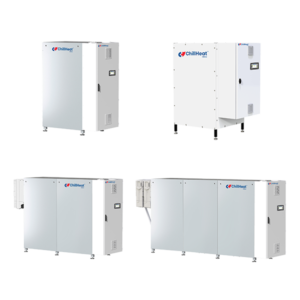SVL News
Coffee Break with Chance Brofft of Oilon Heat Pumps
What Separates Oilon ChillHeat Heat Pumps From Others In The Marketplace?
We asked Chance Brofft from Oilon to explain the new ChillHeat series at our latest Coffee Break webinar. These bimonthly sessions earn attendees 1 PDH and give them up-to-the-minute information on the most exciting technologies in the HVAC market. Be sure to ask your SVL sales engineer for an invite to future Coffee Breaks.
Give us a refresher on the basics of heat pump operation.
Oilon ChillHeat heat pumps operate in the same basic manner as most heat pumps. Liquid refrigerant enters the evaporator, where incoming cold water transfers heat to the refrigerant and exits as chilled water. The refrigerant evaporates, becoming a low-temperature/low-pressure gas, and enters the compressor, where it’s compressed into high-temperature/high-pressure gas. It enters the condenser, where it transfers heat to warm water (which becomes hot water) and condenses back down into liquid refrigerant and goes through the expansion valve to begin the process again.
Typical coefficient of performance (COP) values on ChillHeat heat pumps are between 2 and up to 7 in some cases. This is key for the electrification of HVAC systems because customers looking into electric boilers should note that their COP is never over 1 (meaning that for every 1 kW of energy going into an electric boiler to power it, you’ll never get more than 1 kW of energy out). In contrast, Oilon ChillHeat heat pumps can achieve 6–7 kW of energy going out the condenser side for heating capacity for every 1 kW they consume.
What kinds of heat pumps are in the ChillHeat product family?
 RE Series: heat pumps with scroll compressors, reaching up to 145 °F on the condenser side.
RE Series: heat pumps with scroll compressors, reaching up to 145 °F on the condenser side.- P Series: piston or reciprocating heat pumps. This high-temperature series achieves up to 248 °F hot water.
- S Series: screw compressor heat pumps. This is Oilon’s high-capacity series, which delivers up to 190 °F hot water. The S2000 has 2000 kW of heating capacity.
What has Oilon attempted to achieve with this series of heat pumps?
Demand for heat pumps is rising for many reasons. The cost and supply of natural gas have become imperiled by international conflict. Municipalities are setting emissions regulations for buildings, and so is the federal government. The Council on Environmental Quality’s (CEQ) Federal Building Performance Standard requires agencies to cut energy use and electrify equipment, meaning that agencies will be buying products such as heat pumps, electric water heaters, and other energy-efficient building system technologies supported by the Inflation Reduction Act.
Oilon is headquartered in Finland, where the extreme temperatures have led them to design heat pumps that deliver the highest possible exiting hot water temperatures. Their R&D team researched liquid injection, oil cooling, and refrigerants with various global warming potential (GWP) values.
The result is the ChillHeat P Series, which delivers hot water temperatures that no other manufacturer in North America can match.
Could you give us some more specs?
Their compact and easy-to-maintain design is perfect for retrofits. They have the flexibility to integrate into BAS systems, can work with multiple refrigerant options, and feature a soundproofing enclosure for low noise and low vibration.
The S and P series can come with optional VFDs and an energy measurement system with real-time monitoring. The Oilon Global Monitor sends real-time information about the heat pump and displays key performance indicators in the user interface, making it easier to monitor the system. It improves their products’ UX, reliability, efficiency, durability, and safety.
What are some likely applications?
Though they apply to many installations, there are a few sectors that have seen several hundred installations of ChillHeat heat pumps in Europe and beyond:
- Heat recovery from cooling towers, wastewater treatment plants, refrigeration waste heat, biogas processes and flue gas.
- Simultaneous heating and cooling: Hospitals have a constant load of heating and cooling year-round. Data centers are the same — constant simultaneous demand, and heat recovery possibilities from the heat generated by the servers. The P-series can produce water temperatures for simultaneous heating and cooling. The evaporator side is used for comfort cooling, and the condenser side goes out to a heating loop like a geothermal installation (and the process can be reversed in winter).
What does the future hold for Oilon heat pumps?
Their most significant focus with R&D is dealing with extreme temperatures and producing the hottest possible hot water temperatures. The company hopes to create steam on the condenser side of the heat pumps in the near future.
Be sure to check out an Oilon P-75 unit up close at the ASHRAE conference in Atlanta this February.









































